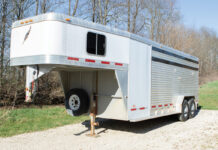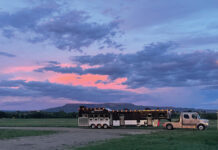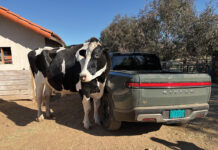Hooking a trailer quickly and correctly requires practice and patience. In order to make sure your trailer is hooked correctly, it’s important to follow the same steps, in the same order, every time you hook and unhook to your tow vehicle.

- To begin, you’ll need to make sure your hitch is cranked up high enough to accept your trailer ball, no matter which type of trailer you’re hauling.
- Next, line up your tow vehicle with the front of the trailer. If your trailer has an embellished paint job (some have a “V” in the front of them), it will be easier to make sure you’re straight. Some truck liners have round impressions in the pour-in liners that denote the middle of the bed. Additionally, you can spray a small circle in the center of your truck bed to help you line up properly, or lay down a broom or farriers rasp to help guide you. For SUV’s, a small sticker or marker on the center bottom of your rear window will help align you more quickly. Also, a step-in fence post or a tall stick can be stuck in the ground just behind the hitch on the trailer to make sure you’re square.

Lining up a gooseneck hitch - Back up in small increments to you trailer’s hitch system. It’s crucial that you do this slowly with bumper-pull trailers so you don’t knock them off any blocks it may be placed on. While this is significantly easier with a person directing you (you should watch them in your mirrors), it’s not always feasible. Be prepared to get in and out of your truck multiple times if you can’t see the ball of your gooseneck or you’re hooking to a bumper pull. There’s no shortcut for simply practicing until you get the feel of your towing vehicle and your trailer.
- Once you get the ball under the hitch, crank the jack down until the hitch lowers on to the ball and release the lock. Some bumper pulls will need a bit of “help” (read: a knock with the heel of your hand or your boot) to slide into place so you can lock the cuff and place the pin through it.
- Plug in your electric. On most rigs, you can check all lights at once by turning on both running lights and emergency flashers.
- If you own a gooseneck, close the tailgate.
- Hook your safety chains. Safety chains on a bumper pull should be crossed (this prevents the tongue from dropping to the ground and digging in if trailer comes off the ball). You will have to hop into the bed of your truck to hook the chains if you’re hauling a gooseneck.

Hook the safety chains or cables - Hook your emergency brake to the tow vehicle. This cable on a bumper pull can run through your frame hitch and hook back to itself. In a gooseneck, it will hook in the same place as your chains. Should your trailer come loose from your tow vehicle, the pin would pull from the battery box (close to the hitch coupler), activating your trailer’s brakes.
- Finally, pick up any wheel chocks or blocks you used to support the jack before driving away.
With enough practice, hitching your trailer will become second nature, but never become complacent in ensuring that every step is completed. Your safety and that of your four-legged best friend is at stake.
Need more? Here are more trailering articles.
Video: Inspecting a Horse Trailer
What Your Horse Needs to Know Before Getting in a Trailer
Finding the Type of Trailer That’s Right for You
10 Things to Know About Financing a Horse Trailer






This is a good example but you have hot told the truth. Every Hitch…Every Trailer used under 3,000 GVWR are using hitch systems and trailers that have NO NATIONAL SAFETY STANDARD!!! You can even make them HOMEMADE! go to dangeroustraialers.org